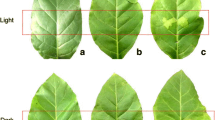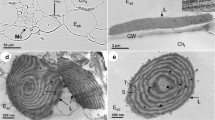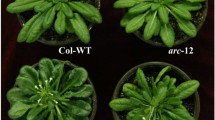Abstract
We examined photosynthetic properties of Eupatorium makinoi leaves infected by a geminivirus. Since a major symptom of the geminivirus infection is variegation or yellowing of leaves, Chl content was used as an index of disease severity. As leaf Chl content was lowered, leaf absorptance, maximal quantum yield of photosynthesis on an absorbed quantum basis (φo2,max) and light-saturated rate of photosynthesis (Pmax) decreased. The share of energy allocated to PS II, which can be estimated from fluorescence parameters and oxygen evolution rate, was about 30% lower in the infected yellow leaves than in uninfected leaves. Analyses of the composition of thylakoid polypeptides by gel electrophoresis showed preferential loss of LHC II. The lower φo2,maxin the infected leaves was, thus, attributed to the decreased energy allocation to PS II. These features were largely consistent with those of b-less mutants, but lowered Pmaxhas been never reported for b-less mutants. Possible mechanisms causing these changes in photosynthetic properties to the infected leaves are discussed.
Similar content being viewed by others
References
Allen JF (1992) Protein phosphorylation in regulation of photosynthesis. Biochim Biophys Acta 1098: 275-335
Andrews JR, Fryer MJ and Baker NR (1995) Consequences of LHC II deficiency for photosynthetic regulation in chlorinamutants of barley. Photosynth Res 44: 81-91
Balachandran S, Osmond CB and Makino A (1994) Effects of two strains of tobacco mosaic virus on photosynthetic characteristics and nitrogen partitioning in leaves of Nicotiana tabacumcv Xanthi during photoacclimation under two nitrogen nutrition regimes. Plant Physiol 104: 1043-1050
Balachandran S and Osmond CB (1994) Susceptibility of tobacco leaves to photoinhibition following infection with two strains of tobacco mosaic virus under different light and nitrogen nutrition regimes. Plant Physiol 104: 1051-1057
Demmig B and Björkman O (1987) Comparison of the effect of excessive light on chlorophyll fluorescence (77K) and photon yield of O2evolution in leaves of higher plants. Planta 171: 171-184
Falbel TG and Staehelin LA (1994) Characterization of a family of chlorophyll-deficient wheat (Triticum) and barley (Hordeum vulgare) mutants with defects in the magnesium-insertion step of chlorophyll biosynthesis. Plant Physiol 104: 639-648.
Falbel TG and Staehelin LA (1996) Partial blocks in the early steps of the chlorophyll synthesis pathway: A common feature of chlorophyll b-deficient mutants. Physiol Plant 97: 311-320
Friess N and Maillet J (1996) Influence of cucumber mosaic virus infection on the intraspecific competitive ability and fitness of purslane (Portulaca oleracea). New Phytol 132: 103-111
Funayama S, Hikosaka K and Yahara T (1997) Effects of virus infection and growth irradiance on fitness components and photosynthetic properties of Eupatorium makinoi(Compositae) Am J Bot 84: 823-829
Genty B, Briantais J-M and Baker NR (1989) The relationship between the quantum yield of photosynthetic electron transport and quenching of chlorophyll fluorescence. Biochim Biophys Acta 990: 87-92
Ghirardi ML, McCauley SW and Melis A (1986) Photochemical apparatus organization in the thylakoid membrane of Hordeum vulgarewild type and chlorophyll b-less chlorina f2 mutant. Biochim Biophys Acta 851: 331-339.
Greene BA, Allred DR, Morishige DT and Staehelin LA (1988) Hierarchical response of light harvesting chlorophyll-proteins in a light-sensitive chlorophyll b-deficient mutant of maize. Plant Physiol 87: 357-364
Hikosaka K (1996) Effects of leaf age, nitrogen nutrition and photon flux density on the organization of the photosynthetic apparatus in leaves of a vine (Ipomoea tricolorCav.) grown horizontally to avoid mutual shading of leaves. Planta 198: 144-150
Hodgson RAJ, Beachy RN and Pakrasi HB (1989) Selective inhibition of Photosystem II in spinach by tobacco mosaic virus: an effect of the viral coat protein. FEBS Lett 245: 267-270
Kelly SE (1993) Viruses and the advantage of sex in Anthoxanthum odoratum: A review. Plant Species Biol 8: 217-223
Leal N and Lastra R (1984) Altered metabolism of tomato plants infected with tomato yellow mosaic virus. Physiol Plant Pathol 24: 1-7
Melis A and Homann PH (1975) Kinetic analysis of the fluorescence induction in 3-(3,4-dichlorophenyl)-1,1-dimethylurea poisoned chloroplasts. Photochem Photobiol 21: 431-437
Melis A and Homann PH (1976) Heterogeneity of the photochemical centers in system II of chloroplasts. Photochem Photobiol 23: 343-350
Naidu RA, Krishnan M, Ramanujam P, Gnanam A and Nayudu MV (1984a) Studies on peanut green mosaic virus infected peanut (Arachis hypogaeaL.) leaves. I. Photosynthesis and photochemical reactions. Physiol Plant Pathol 25: 181-190
Naidu RA, Krishnan M, Nayudu MV and Gnanam A (1984b) Studies on peanut green mosaic virus infected peanut (Arachis hypogaeaL.) leaves. II. Chlorophyll-protein complexes and polypeptide composition of thylakoid membranes. Physiol Plant Pathol 25: 191-198
Olesinski AA, Lucas WJ, Galun E and Wolf S (1995) Pleiotropic effects of tobacco-mosaic-virus movement protein on carbon metabolism in transgenic tobacco plants. Planta 197: 118-126
Platt SG, Henriques F and Rand L (1979) Effects of virus infection on the chlorophyll content, photosynthetic rate and carbon metabolism of Tolmiea menziesii. Physiol Plant Pathol 16: 351-365
Porra RJ, Thompson WA and Kriedemann PE (1989) Determination of accurate extinction coefficients and simultaneous equations for assaying chlorophylls aand bextracted with four different solvents: verification of the concentration of chlorophyll standards by atomic absorption spectroscopy. Biochim Biophys Acta 975: 384-394
Reinero A and Beachy RN (1986) Association of TMV coat protein with chloroplast membranes in virus-infected leaves. Plant Mol Biol 6: 291-301
Reinero A and Beachy RN (1989) Reduced Photosystem II activity and accumulation of viral coat protein in chloroplasts of leaves infected with tobacco mosaic virus. Plant Physiol 89: 111-116
Sheen J (1994) Feedback control of gene expression. Photosynth Res 39: 427-438
Sonoike K and Terashima I (1994) Mechanism of Photosystem-I photoinhibition in leaves of Cucumis sativusL. Planta 194: 287-293
Sonoike K (1996) Photoinhibition of Photosystem I: Its physiological significance in the chilling sensitivity of plants. Plant Cell Physiol 37: 239-247
Tan PHN, Wong SM, Wu M, Bedford ID, Saunders K and Stanley J (1995) Genome organization of Ageratumyellow vein virus, a monopartite whitefly-transmitted geminivirus isolated from a common weed. J Gen Virol 76: 2915-2922
Terao T, Sonoike K, Yamazaki J, Kamimura Y and Katoh S (1996) Stoichiometries of Photosystem I and Photosystem II in rice mutants differently deficient in chlorophyll b. Plant Cell Physiol 37: 299-306
Terao T, and Katoh S (1996) Antenna sizes of Photosystem I and Photosystem II in chlorophyll b-deficient mutants of rice. Evidence for an antenna function of Photosystem II centers that are inactive in electron transport. Plant Cell Physiol 37: 307-312.
Terashima I, Kashino Y and Katoh S (1991) Exposure of leaves of Cucumis sativusL. to low temperatures in the light causes uncoupling of thylakoids. I. Studies with isolated thylakoids. Plant Cell Physiol 32: 1267-1274
Terashima I, Funayama S and Sonoike K (1994) The site of photoinhibition in leaves of Cucumis sativusL. at low temperatures is Photosystem I, not Photosystem II. Planta 193: 300-306
Yahara T and Oyama K (1993) Effects of virus infection on demographic traits of an agamospermous population of Eupatorium chinense(Asteraceae). Oecologia 96: 310-315
Author information
Authors and Affiliations
Rights and permissions
About this article
Cite this article
Funayama, S., Sonoike, K. & Terashima, I. Photosynthetic properties of leaves of Eupatorium makinoi infected by a geminivirus. Photosynthesis Research 53, 253–261 (1997). https://doi.org/10.1023/A:1005884007183
Issue Date:
DOI: https://doi.org/10.1023/A:1005884007183




